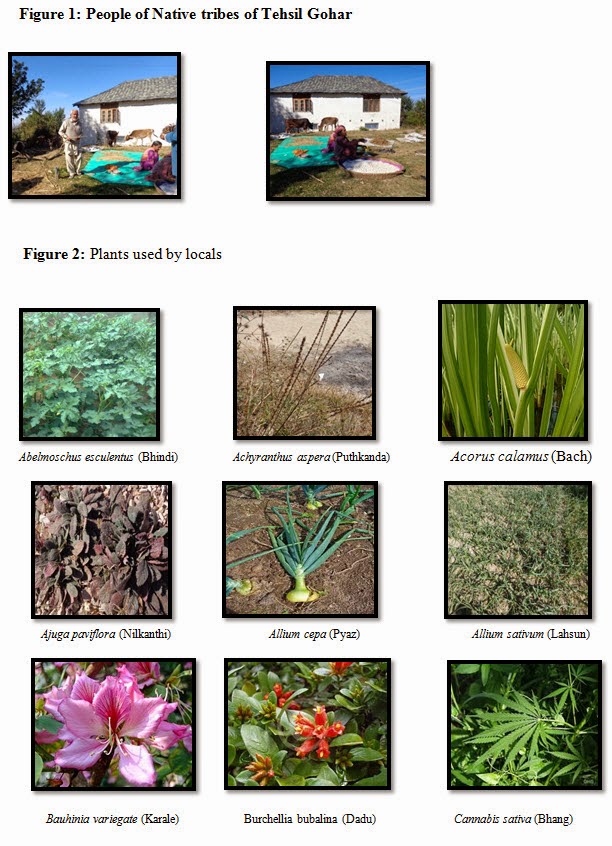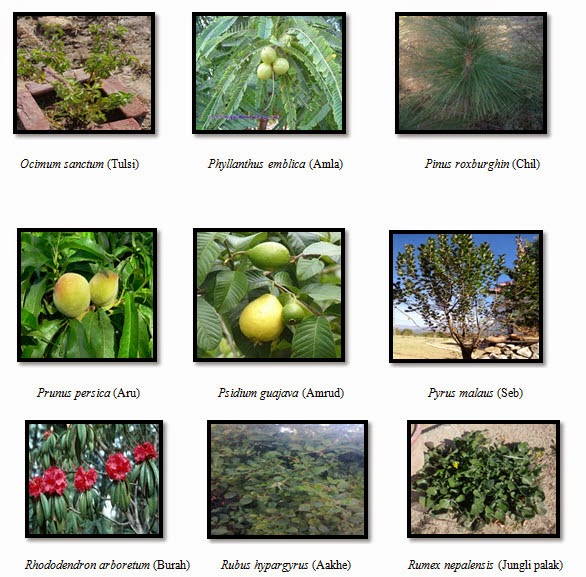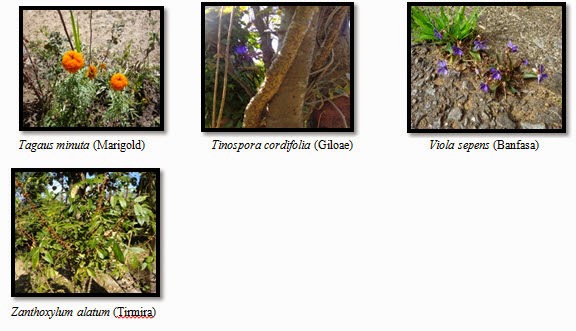{ DOWNLOAD AS PDF }
 ABOUT AUTHORS:
ABOUT AUTHORS:
Monika Rana*1, Atul Kabra1, Ruchika Kabra1, Meenakshi Rana2, Vinay Dhatwalia3
1 Department of Pharmacy, Abhilashi university, Chailchowk, Mandi (H.P)
2 HIPER college of Pharmacy, Nadaun, (H.P)
3 Abhilashi College of Pharmacy, Mandi (H.P)
*sairana.rana43@gmail.com
ABSTRACT
Objective: An exhaustive ethno medicinal investigation of plants was carried out in Gohar Tehsil of Distt. Mandi.
Methods: The paper encompasses 38 medicinal plants, collected from forest of Chailchowk and its adjoining areas, and authenticated. The information was collected from local people. This study reveals the status of ethno-medicinal plants and their importance preserved by locals of Gohar Tehsil of Distt. Mandi.
Results: Total 38 medicinal plants were studied in the forest of Chailchowk Village and its adjoining areas of Gohar Tehsil are very valuable medicinal plants which are already known for their numerous medicinal values.
Conclusion: This study will assist the forest, pharmaceutical firm, medicos and wild life manager in their efforts for improving the public health service and medicinal plant wealth of the area.
REFERENCE ID: PHARMATUTOR-ART-2324
|
PharmaTutor (ISSN: 2347 - 7881) Volume 3, Issue 4 How to cite this article: M Rana, A Kabra, R Kabra, M Rana, V Dhatwalia; Plant Species used by locals as Ethano - Medicine in Gohar Tehsil, Distt. Mandi Region of North Western Himalaya; PharmaTutor; 2015; 3(4); 47-52 |
INTRODUCTION
Western Himalaya is a reservoir of many natural resources, of which vegetational aspect is predominant [1]. The Indian Himalayan region extending from Jammu and Kashmir in the North –West to the Arunachal Pradesh in the east cover approximately 4,19,873 km2 area. [2]
Traditional folklore knowledge is a treasure of India, plays an important role in rural population. Traditional medicines are used by our ancestors since time long for their well being and transmitted orally from one generation to another. According to WHO report, rural and tribal population still uses traditional medicines to cure various disease with the natural harmony. In 2008, global market of traditional medicines was estimated 83 billion $ and 25% of modern medicines are procured from plants [3]. Today about 65% of Indian population depend on the traditional system of medicine [4]. They diagnose and cure different diseases through their own traditional knowledge [5]. Chailchowk is a village in Gohar Tehsil in Mandi Distt. of Himachal Pradesh. It is located about 29 km from Mandi and 24 km from Sunder Nagar. The forest of Himachal Pradesh are reservoir of a large number of medicinal and aromatic plants due to varied climatic condition that support the survival of flora. Local healer and villagers of Tehsil Gohar use numerous plants for their health care needs. The present information can serve as the foundation for further investigations because till date, no ethno botanical study has been undertaken. Hence, the study was undertaken and documented.
MATERIALS AND METHODS
During the survey all plant specimens were collected, identified. The plant specimens were collected from forest of Chailchowk Village and its adjoining areas of Tehsil Gohar. The information regarding the plants was gathered by the personal interview with experienced local persons (Figure 1) and with the help of various ayurvedic books.The plant specimens were collected and pressed in the blotting paper for removal of moisture, then the herbarium sheet is prepared. Data related to each ethno botanical aspects were collected from local people of that area. The authentification done by Dr. Suresh Kumar (Abhilashi Group of Institution) and with the help of various literature survey.
RESULT
Total 38 medicinal plants were studied in the Gohar Tehsil forest, are very valuable medicinal plants which are already known for their medicinal values. These plants are used commonly in every house. Among these plant species, the maximum plants were used for cough and cold, skin disease and in inflammation. Some plants species in addition to their medicinal importance are of cultural and religious importance. Plants used by locals were tabulated in alphabetical order of family, botanical name, uses and using procedure (Table 1) and shown in (Figure 2)
CONCLUSION
Medicinal plants were playing a vital role in curing health.Vaidhyas and other knowledgeable persons have been keeping huge traditional as well as indigenous knowledge about medicinal plants in perspective of their identification, ethno-medicinal uses and using procedures since long time. Hence, there is an urgent need to conserve their indigenous as well as traditional through documented literature and proper interaction with younger generation. Because the natural or herbal reservoir of Himalayan region have been depleting day by day due to lack of proper knowledge in younger generation. This study will assist the forest, pharmaceutical firm, medicos and wild life manager in their efforts for improving the public health service and medicinal plant wealth of the area.
Table 1: List of Plants [6,7,8,9]
|
S .No |
Plants Name |
Family |
Local Name |
Uses |
|
1. |
Abelmoschus esculentus |
Malvaceae |
Bhindi |
Fresh seeds are grounded and applied on wounds externally. And used as vegetable. |
|
2. |
Achyranthus aspera |
Amaranthaceae |
Puthkanda, Apamarg |
Crushed seeds applied on bleeding piles. Fresh stem is chewed for toothache. |
|
3. |
Acorus calamus |
Araceae |
Bach, Bare |
Roots used in cold and caugh, used to cure headach, and as anti-inflammatory. |
|
4. |
Ajuga paviflora |
Lamiaceae |
Nilkanthi |
Root and leaf part used in ear ach, dysentery and in fever |
|
5. |
Allium cepa |
Alliaceae |
Pyaz |
Used as ear drop in ear ach, and in indigestion. |
|
6. |
Allium sativum Linn. |
Amaryllidaceae |
Lahsun |
Bulb used Joint pain, used as ear drop in ear ach, skin diseases and in GIT disorder. |
|
7. |
Bauhinia variegata Linn |
Fabaceae |
Karale |
Roots, Flowers part used in diarrhea, Young flowers bud are used as food material. |
|
8. |
Burchellia bubalina |
Rubiaceae |
Dadu |
The roots provide an infusion and used as food material |
|
9. |
Cannabis sativa |
Cannabaceae |
Bhang |
Whole plant used as Narcotics, Sedative, anti-inflammatory. Leaves are used for religious purposes |
|
10. |
Cedrus dodara |
Pinaceae |
Dyar, Devdar |
Bark used as antidote in snake poisoning, piles, kidney stone, diuretic. |
|
11. |
Centella asiatica |
Apiaceae |
Brahmi, Handumalu |
Throat pain, nervine tonic, memory enhancer, improve healing, skin diseases especially in acne vulgaris. |
|
12. |
Cinnamomum tamala |
Lauraceae |
Dalchini, Mithapata, Tejpata |
Chewing of leaves used in Pyorrhea. Used as flavoring agent |
|
13. |
Citrus limonis |
Rutaceae |
Nimbu |
Juice is taken orally for indigestion, and as facial purpose. |
|
14. |
Coriandrum sativum |
Apiaceae |
Dhaniya |
Fresh juice applied on scalp to treat dandruff. And used in cooking |
|
15. |
Curcuma longa |
Zingiberaceae |
Haldi |
Wound healing and in inflammation, paste of fresh rhizome mixed with warm water is given to heal up internal wounds, treatment of acne. |
|
16. |
Dioscorea deltoida |
Dioscoriaceae |
Taradi |
Anti-inflammatory, dietary modulator and as food material. |
|
17. |
Euphorbia heliscopia |
Euphorbiaceae |
Dudhali |
Skin eruption, cholrea, and having anticancer activity. |
|
18. |
Fennel |
Umbelliferae |
Sounf, Dhansoya |
Help in digestion, and also used as flavoring agent |
|
19. |
Ficus carica |
Moraceae |
Fagde |
Diuretic, Purgative. |
|
20. |
Juglans regia |
Juglandaceaea |
Akhrot |
Skin ailments, blood purifier, constipation, backpain, anemia. |
|
21. |
Mentha sylvestris |
Lamiaceae |
Pudina |
Juice in diarrhoea, indigestion, remove bad smell of mouth, antispasmodic. |
|
22. |
Morchella esculenta |
Morchellaceae |
Guchi, dunglu |
Indigestion, in stomachach Immunoregulatory, Antiviral, antioxidant. |
|
23. |
Morus nigra |
Moraceae |
Sehtoot, chimu |
Hallucinogenic |
|
24. |
Murraya koenigii |
Rutaceae |
Gandala, Karripata |
As Flavouring agents in food and branches used for cleaning of teeth. |
|
25. |
Myrica esculanta |
Myricaceae |
Kaphal |
Stomach disorder, respiratory disorder. |
|
26. |
Ocimum sanctum |
Lamiaceae |
Tulsi |
Cough and cold; leaves boil with water and used as green tea, which effective in reducing stress. |
|
27. |
Phyllanthus emblica |
Euphorbiaceae |
Amla |
Source of vitamin c, Fruits used as food, dried fruits grind and used for cleaning hairs. |
|
28. |
Pinus roxburghin |
Pinaceae |
Chil |
Skin problems, cough, ulcers, wounds, cold influenza. |
|
29. |
Prunus persica |
Rosaceae |
Aru |
Astringent |
|
30. |
Psidium guajava |
Myrtaceae |
Amrud |
Branch lets used as toothbrush, fruit is used in controlling blood pressure. |
|
31. |
Pyrus malaus |
Rosaceae |
Seb |
Astringent, laxative and anaemia. |
|
32. |
Rhododendron arboretum Smith |
Ericaceae |
Burah |
In nosebleed, menstrual disorder, headach, cough, astringent. |
|
33. |
Rubus hypargyrus |
Rosaceae |
Aakhe |
Laxative |
|
34. |
Rumex nepalensis |
Polygonaceae |
Jungli palak |
Purgative, swollen gums |
|
35. |
Tagaus minuta |
Asteraceae |
Marigold |
Gastritis, skin infection and internal worms. |
|
36. |
Tinospora cordifolia |
Menispermaceae |
Giloe, Gulaje |
Joints pain, tonic, antiperiodic. Dried stem are also used for religious purposes called “Hawan”. |
|
37. |
Viola sepens
|
Violaceae |
Banfsha |
In cold and cough |
|
38. |
Zanthoxylum alatum |
Rutaceae |
Tirmira |
Toothache, fever, carminative, tonic, remove bad smell from teeth. |
NOW YOU CAN ALSO PUBLISH YOUR ARTICLE ONLINE.
SUBMIT YOUR ARTICLE/PROJECT AT editor-in-chief@pharmatutor.org
Subscribe to Pharmatutor Alerts by Email
FIND OUT MORE ARTICLES AT OUR DATABASE





REFERENCES
1. Singh G, Rawat G S. Ethnomedicinal Survey of Kedarnath Wildlife Sanctuary in Western Himalaya, India. Ind J Fund Appl Life Sci 2011; 1(1): 35-46.
2. Rdger W A, Panwar W S. Planning a Wildlife Protected area Network In India, (1988). Vols 1 and 2. Wildlife Institute of India, Dehradun.
3. Randhava N K. Ethno-Botanical Study of Medicinal Plants Used in Ramdass, Ajanala. District of Amritsar, Punjab. Int. J. Pharm. Biomed. Res 2013; 4 (3): 911-13.
4. Timmermans K. Intellectual property rights and traditional medicine: Policy dilemmas at the interface. World Health Organization, Jakarta 2003.
5. Hafeel A, Shankar D. Revitalizing indigenous health practices. COMPAS Newsletter 1999. p.28-29.
6. Sharma P. Dravyaguna Vigyan. Published by Chokhamba Bharti Academy Varanasi 2005.p.3, 25,149,162.
7. Sharma P, Vidyarthi S, Nath S. Study of medicinal Phytodiversity of Janjehli, Rohanda and adjoining areas, H.P. J Non-Timber Forest Prod., 2011 18(2): 141-148.
8. Paranjpe P. Indian Medicinal Plant (Forgotten healers). Chaukhamba Sanskrit Pratishthan Delhi 2012.p.5, 68, 94, 165, 220,271.
9. Sharma D P. Banoshadi Shatak. Published by Shri Baidyanath Ayurveda Bahawan Ltd. Kolkata 2013.p.27, 70, 130, 104, 143, 207, 218, 243.
NOW YOU CAN ALSO PUBLISH YOUR ARTICLE ONLINE.
SUBMIT YOUR ARTICLE/PROJECT AT editor-in-chief@pharmatutor.org
Subscribe to Pharmatutor Alerts by Email
FIND OUT MORE ARTICLES AT OUR DATABASE











.png)

